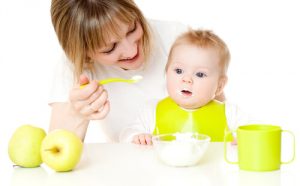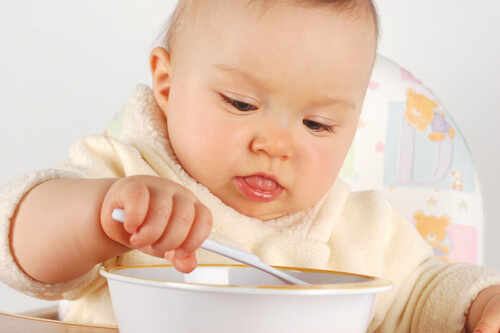Dessert Recipes for Babies from the Age of 9 to 12 Months


Written and verified by the nutritionist Saúl Sánchez Arias
Desserts, milkshakes, mousse and puddings. There are many different dessert recipes. However, the nutritional benefits and the joy they bring to your baby are essential.
In this article we’ll share with you a few dessert recipes for babies from the age of 9 to 12 months. You don’t need a massive kitchen nor a lot of time to make them, so don’t worry.
It’s common for babies to have a preference towards sweet flavors. This is because it reminds them of breast milk which was their only diet until they reached the age of 8 months.
In general, most people prefer a sweet taste rather than a savory one. It’s tough to resist an exquisite dessert, delicious ice-cream or a succulent flan.
But we can also opt for healthier alternatives such as desserts and milkshakes made out of fruits.
A baby’s taste glands are very sensitive during the first few months of life, that’s why they reject sour flavors. This forms part of their survival instinct.
So, here are four dessert recipes that you and your baby will love. Try them out and help your child explore new flavors.
4 dessert recipes for babies from the age of 9 to 12 months
During this phase of life, their diet starts to become similar to that of the rest of the family.
Of course, it’s important to make a few adaptations in order for them to be able to ingest the foods without problems.
Sweet foods can be an excellent snack or dinner. It’s best to use fresh nutrient-rich ingredients with different textures, colors and tastes in order to amplify the baby’s dietary repertoire.

-
Apple and kiwi puree
One of the first fruits that is recommended for babies are apples. When mixed with other fruits such as pear or kiwi, you can make an exquisite puree with important nutritional benefits.
Ingredients
- 1/4 peeled kiwi
- 1/4 peeled apple
Preparation
- Blend the kiwi.
- Pass it through a fine sieve in order to take out all of the seeds.
- Blend the apple and mix it all together.
The benefits of apples are well known. They have very little fats and protein while providing a huge amount of minerals, such as potassium.
Apples also provide many vitamins and are very good for the digestive system because they can be digested easily and contain a lot of fiber.
-
Yogurt with fruits
Yogurt is an excellent food for babies who are 9 to 12 months old since it facilitates digestion. It also has a smooth texture.
You should always select yogurt that is suitable for babies since they don’t consume the same yogurt that adults do.
When combined with fruits such as pears, bananas or apples it’s an excellent way to provide your baby with a balanced diet.
Ingredients
- 100g of apple.
- Yogurt for babies.
- 2 spoons of jam.
Preparation
- Wash, peel and cut the apple into small pieces.
- Put the pieces of apple into the blender along with the jam and yogurt.
-
Quinoa and banana puree
This is one of the most nutritious snacks that we can provide for our babies.
Quinoa has wonderful properties. It’s nutritious, low in calories, contains bio-active substances and provides huge amounts of fiber.
Bananas are also very healthy for babies, since they favor the proper functioning of the digestive system. That’s why this is one of our most recommended dessert recipes for babies from the age of 9 to 12 months.
Ingredients
- 1/2 banana
- 1 dash of cinnamon
- 3 teaspoons of cooked quinoa
- 1 spoon of special baby yogurt
Preparation
- Place the peeled banana in a bowl and mash it with a fork.
- Add the cooked quinoa, cinnamon and yogurt.
- Mix and serve.
“It’s best to use fresh nutrient-rich ingredients with different textures, colors and tastes in order to amplify the baby’s dietary repertoire.”
-
Banana mousse
This is another excellent way to incorporate bananas into your baby’s diet. This dessert’s consistency is a bit more liquid, but it’s just as delicious.
Ingredients
- 3 bananas.
- 150g of yogurt.
- 1 spoon of honey.
- 1/2 lemon.
Preparation
- Blend the peeled bananas along with the lemon juice and yogurt.
- Add honey and blend until it reaches a creamy consistency.
- Serve in cups and place in the fridge until it gets cold.
In addition to the recipes mentioned above, you can create variations by adding different types of fruit according to your child’s taste.
It’s important for you to provide them with a healthy diet from an early age and of course, make sure they’re receiving all of the nutrients they need.
All cited sources were thoroughly reviewed by our team to ensure their quality, reliability, currency, and validity. The bibliography of this article was considered reliable and of academic or scientific accuracy.
- Agencia Catalana de Salud Pública. Recomendaciones para la alimentación en la primera infancia (de 0 a 3 años). Agencia de Salud Pública de Cataluña. Diciembre 2016.
- An R., Wilms E., Smolinska A., Hermes GDA., et al., Sugar beet pectin supplementation did not alter profiles of fecal microbiota and exhaled breath in heatly young adults and healthy elderly. Nutrients, 2019.
- Centers for Disease Control and Prevention. Alimentos y bebidas que se deben limitar. Departamento de Salud y Servicios Humanos del Gobierno de Estados Unidos. Diciembre 2020.
- Fernandez M. A, Marette M. A. Potential health benefits of combining yogurt and fruits based on their probiotic and prebiotic properties. Advances in Nutrition. Enero 2017. 155S-164S.
- Fidler Mis N, Braegger Ch, et al. Sugar in infants, children and adolescents: a position of the European Society for Paediatric Gastroenterology, Hepatology and Nutrition Committee on Nutrition. Journal of Pediatric Gastroenterology and Nutrition. Diciembre 2017. 65 (5): 681-696.
- Forrestell C. A. Flavor perception and preference development in human infants. Annals of Nutrition and Metabolism. 2017. 70 (Suppl 3).
- Gómez Fernández-Vegue M. Recomendaciones de la Asociación Española de Pediatría sobre la alimentación complementaria. Comité de Lactancia Materna y Comité de Nutrición de la Asociación Española de Pediatría. Noviembre 2018.
- Maradini Filho A. M, Riberiro Pirozi M, et al. Quinoa: nutritional, funcitonla and antinutritional aspects. Critical Reviews in Food Science and Nutrition. Mayo 2017. 57 (8): 1618-1630.
- Stanhope KL., Sugar consumption, metabolic disease and obesity: the state of the controversy. Crit Rev Clin Lab Sci, 2016. 53 (1): 52-67.
- U. S. Department of Agriculture and U. S. Department of Health and Human Services. Dietary Guidelines for Americans. 2020-2025. 9th Edition. Diciembre 2020.
- Ventura A. K, Mennella J. A. Innate and learned preferences for sweet taste during childhood. Current Opinion in Clinical Nutrition and Metabolic Care. Julio 2011. 14 (4): 379-84.
This text is provided for informational purposes only and does not replace consultation with a professional. If in doubt, consult your specialist.
